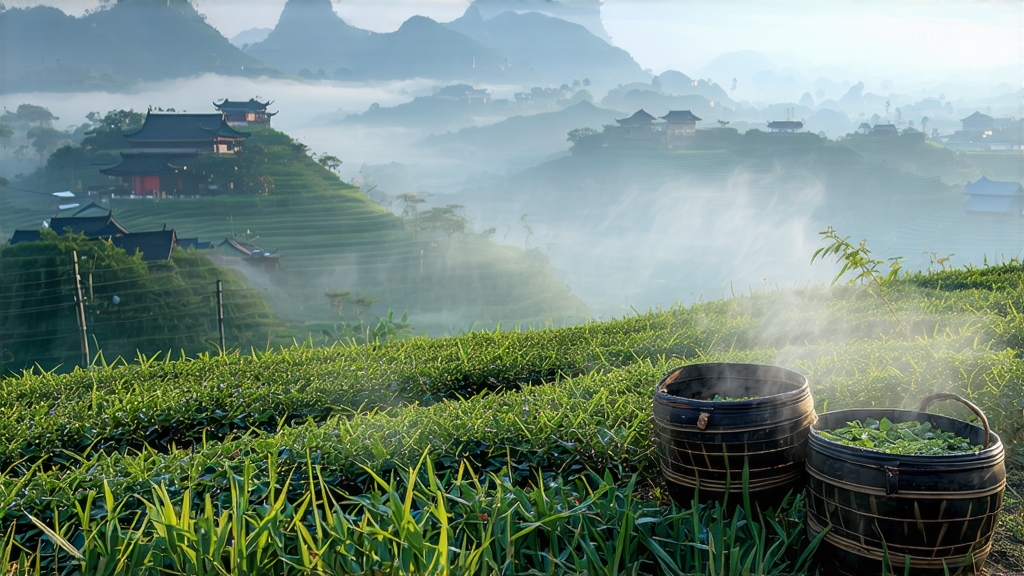
Liu Bao, literally “Six Forts,” is the name of a small market town in the southern Chinese province of Guangxi, yet to tea historians it is shorthand for one of the oldest continuously produced dark teas on earth. While Pu-erh has stolen the international spotlight, Liu Bao has spent four centuries quietly perfecting its own style of post-fermentation, developing a mellow, medicinal liquor that once rode the same horse caravans as silk and opium to the borders of Southeast Asia. Today the tea is experiencing a quiet renaissance among Chinese sommeliers who prize its camphor-cool finish and its uncanny ability to taste like the forest after rain.
History: From Frontier Currency to Maritime Ballast
The earliest written record appears in the 1664 edition of the Cangwu County Gazetteer, noting that “the people of Liu Bao compress leaves into square bricks for barter with Yao tribes.” By the Qing dynasty the tea had become a form of currency in the mountainous Sino-Vietnamese borderlands; compressed “fang bao” bricks were stamped with official seals and used to pay imperial taxes. When the British opened the treaty port of Guangzhou, Liu Bao was loaded as ballast in the belly of clipper ships bound for Singapore and Kuala Lumpur, where it cooled the blood of tin miners and became the grandfather of Malaysian “Kampung Boh” dark tea culture. In 1950 the state-designated Wuzhou Tea Factory mechanized production to supply ethnic minorities who still needed the tea for butter broths and postpartum recovery, cementing Liu Bao’s reputation as a beverage of endurance.
Micro-terroirs within One County
Purists divide Liu Bao into three micro-zones. The highest gardens, at 800–1,000 m in the Da Gui Shan range, yield leaves rich in linalool and give a lilac nose reminiscent of old Burgundy. Mid-elevation terraces around the Qian Jiang tributary produce broader leaves with higher polyphenol oxidase activity, translating into a deeper crimson cup and a sweet potato sweetness. The lowest belt, near the humid floodplains of the Xi Jiang River, is prized for “golden flower” bricks whose surface blooms with Eurotium cristatum, the same yellow mold celebrated in Hunan Fu brick tea. Each zone is further split by cultivar: the traditional Shan Cha wild varietal offers resinous pine notes, while the 1958-introduced Yun Kang Da Ye gives a velvet body favored by Hong Kong tea merchants.
Craft: The Secret 48-Hour Steam Bath
Unlike Pu-erh’s sun fixation, Liu Bao undergoes a unique “wet piling” indoors. Fresh leaves are withered overnight on bamboo racks, then wok-fired at 280 °C for eight minutes to arrest green character. While still hot, the leaf is piled 70 cm deep inside cedar-lined chambers. Workers pour river water that has rested in open vats for three days to dissipate chlorine; the water is infused with the previous batch’s “old mother” liquor, a microbial starter akin to sourdough. A 48-hour anaerobic fermentation follows, during which internal pile temperature is not allowed to exceed 55 °C; every two hours the pile is turned by shovel to oxygenate the periphery and re-wet the core. The result is a leaf that has turned from jade to chestnut without ever tasting of sour rot. After piling, the tea is steamed, compressed into 50 kg bamboo baskets lined with wild banana leaf, and transferred to government-approved humid warehouses where it will age for a minimum of three years at 28 °C and 78 % relative humidity. During this time the basket’s bamboo breathes, imparting a signature cooling note that connoisseurs liken to camphor or mint.
Grades & Shapes
Liu Bao is sold in four traditional shapes. “San Cha” loose leaf is destined for immediate drinking, offering a bright, woody cup. “Tiao Cha” rope-twist bundles were designed for mule transport; twisting fractures cell walls, accelerating aging and deepening color. “Fu Zhuan” mini bricks of 200 g are inoculated with golden flowers and taste of dried longan. The most collectible form is “Da Lan” basket tea: 30–50 kg pressed into a cylindrical bamboo corset stamped with the production team number and the lunar calendar date. A 1973 Da Lan fetched USD 28,000 at a Guangzhou auction in 2019, its liquor described as “liquid mahogany that smells of incense temples after